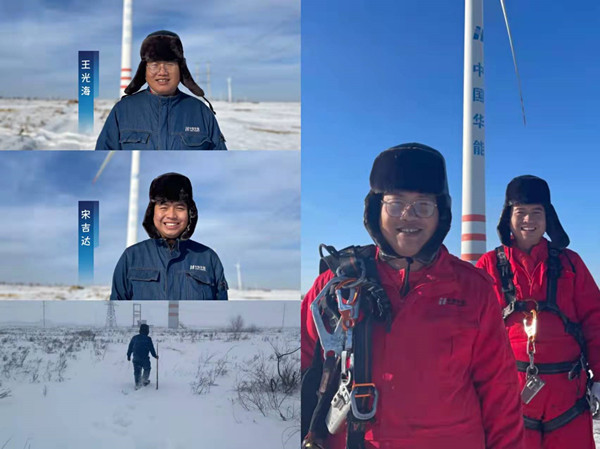Standing upright in the vast plain are rows of blowers towering up to the sky, running the same cycle day after day, generating power for huge numbers of families.
Behind the continuously-working windmills are a group of people who work 24/7 inspecting and guaranteeing operation of the machines. They are called the catcher on the wind farm at China Huaneng Group Co., Ltd. (China Huaneng).
Located on the Zhurihe Grassland in Tongliao, North China's Inner Mongolia Autonomous Region, China Huaneng's Wuliji Wind Farm has a total installed capacity of 295,500 kilowatts. Workers are responsible for operation and maintenance of 189 wind blowers. Checking performances of the machines is a daily routine.
In the early morning of one day in December, 2021, Wang Haiguang and Song Jida set out for a repair mission soon after they received the message about halting of nine wind blowers and six box-type substations.
As the halt machines were situated deeply in the grassland where ice was still thick, Wang and Song had to abandon the vehicle and head to the repairing location on foot. After half an hour of hiking and carrying more than 10 kilograms of toolkit against extremely cold weather, they reached the halt machines and conducted more than three hours of inspection and repair.
It took them 12 hours to fix all the machines that day and their coats, soaked with sweat, were frozen.

Wang Haiguang (L1) and Song Jida (L2) hike in the grassland covered in heavy snow to repair the halt machines. [Photo/sasac.gov.cn]
"Guaranteeing safe and stable operation of wind blowers on the vast Gobi desert is our incumbent duty," Meng Nanbo, a China Huaneng staff member responsible for operation and maintenance at the Anbei Wind Farm in Guazhou County, Northwest China's Gansu Province, said.
Checking more than 200 wind blowers against the strong sand storm in the Gobi Desert is Meng and his colleagues' daily work.
Every morning at 8:30, Meng and his fellows would learn about the weather and carry on inspection toolkit weighing more than 10 kilograms, starting on their journey of machine inspection and repairs.
After half an hour's drive, they would arrive at the site where the wind blowers were situated. Wearing life security devices, they would climb onto the wind blower, reading drawing paper of the circuit of the control cabinet and inspecting the fault point at the blower cabin 95 meters over the ground.
They often have to have their lunch on the wind blower and continue their work soon after the meal. Normally, they complete a day's work at around 8 o'clock in the evening

Meng Nanbo inspects the circuit of a control cabinet of a wind blower 95 meters above the ground. [Photo/sasac.gov.cn]
It is the same story on stage at China Huaneng Fubei Wind Farm in Fuxin, Northeast China's Liaoning Province, which is equipped with 257 wind blowers and has an installed capacity of 397,500 kilowatts.
Wang Wei and Liu Chundong, staff members working at the wind farm, received the fault warning sent by the wind farm monitoring system, which showed fault of a direct current screen charger at the booster station in east of the farm, at noon on a cold winter day in 2021.
They immediately took the tools and rushed to the fault site about 20 kilometers away from the main station. Due to the heavy snow storm, it took them four hours to reach the site.
They cleaned the snow that covered the gate and completed the repair at 7 o'clock in the evening. To ensure stable performance of the equipment, Wang and Liu stayed at the equipment cabinet for a whole night, keeping an eye on the running machine.
Whatever the weather is like and whenever the machine fault occurs, China Huaneng workers are always on their way to guarantee power and energy supply.

Wang Wei (L) and Liu Chundong (R) hike through the heavy snow to inspect power generation machines. [Photo/sasac.gov.cn]
(Executive editor: Wang Ruoting)